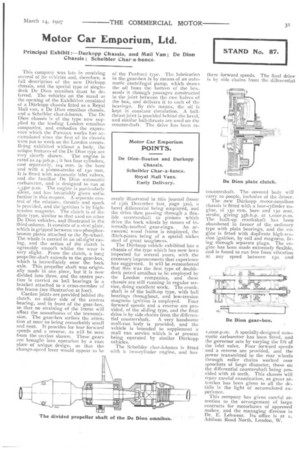Motor Car Emporium, Ltd.
Page 31

If you've noticed an error in this article please click here to report it so we can fix it.
Principal Exhibit:—Durkopp Chassis, and Mail Van ; De Dion Chassis; Scheibler Char-a-bancs.
This company was late in receiving several of its vehicles and, therefore, a full description of the new Dtirkopp chassis, and the special type of singledeck De Dion omnibus must be deferred. The vehicles on the stand at the opening of the Exhibition consisted of a Dtirkopp chassis fitted as a Royal Mail van, a De Dion omnibus chassis, and a Scheibler char-h-bancs. The De Dion chassis is of the type now supplied to the leading London omnibus companies, and embodies the experience which the Puteaux works has accumulated since the first of its chassis were put to work on the London streets. Being exhibited without a body, the unique features of the De Dion type are very clearly shown. The engine is rated as 24-3oh.p. ; it has four cylinders, cast separately, 104 trim. in the bore and with a piston-stroke of 231) mm. It is fitted with automatic inlet valves, and the familiar De Dion automatic carburetter, and is designed to run at 1,35or.p.m. The engine is particularly silent, and has invariably given satisfaction in this respect. A separate control of the mixture, throttle and spark is provided, and the ignition is by hightension magneto. The clutch is of the plate type, similar to that used on other De Dion vehicles, and illustrated in the third column. It consists of a steel plate, which is gripped between two phosphorbronze plates attached to the fly-wheel. The whole is carried in an oil-tight casing, and the action of the clutch is agreeably smooth whilst the wear is very slight. From the clutch, a long propeller-shaft extends to the gear-box, which is immediately over the back axle. This propeller shaft was originally made in one piece, but it is now divided into three, and the centre portion is carried on ball bearings in a bracket attached to a cross-member of the frame (see illustration at foot).
Cardan joints are provided behind the clutch, on either stde of the central bearing, and in front of the gear-box, so that no straining of the frame will affect the smoothness of the transmission. The gear-box strikes the atten. tion at once as being remarkably small and neat. it provides for four forward speeds and a reverse, as will be seen from the section • shown. These gears are brought into operation by a cam plate of unique design, so that the change-speed lever would appear to be
of the Panhard type. The lubrication in the gear-box is by means of an automatic centrifugal pump, which draws the oil from the bottom of the box, sends it through passages constructed in the joint between the two halves of the box, and delivers it to each of the bearings. By this means, the oil is kept in constant circulation. A ballthrust joint is provided behind the bevel, and similar ball-thrusts are used on the txnuttershaft. The drive has been re cently illustrated in this journal (issue of 13th December last, page 320), bevel differential being employed, and the drive then passing through a flexible countershaft to pinions which drive the back wheels by means of in
ternally-toothed gear-rings. An armoured wood frame is employed, the flitch-plates being of a special nickel steel of great toughness.
The Dtirkopp vehicle exhibited has a chassis of the type which has now been imported for several years, with the necessary improvements that experience has suggested. It will be remembered that this was the first type of doubledeck petrol omnibus to be employed by the London companies, and these chassis are still running in regular service, doing excellent work. The crankshaft is of the built-up type, with ball bearings throughout, and low-tension magneto ignition is employed. Four forward speeds and a reverse are provided, of the sliding type, and the final drive is by side chains from the differen tial countershaft. A very handsome mail-van body is provided, and the vehicle is intended to supplement a mail van service which is at present being operated by similar Diirkopp vehicles.
The Scheibler char-A-banes is fitted with 'a two-cylinder engine, and has three forward speeds. The final drive is by side chains from the differential
countershaft. The covered body will carry 20 people, inclusive of the driver.
The new Dfirkopp motor-omnibus chassis is fitted with a four-cylinder engine, of 150 mm. bore and I30 mm. stroke, giving 35b.h.p. at t,000r.p.m. The built-up crankshaft has been abandoned in favour of the ordinary type with plain bearings, and the engine is fitted with duplicate high-tension ignition, by coil and magneto, firing through separate plugs. The engine has been made extremely flexible, and is found to run free from vibration at any speed between 150 and ,000r.p.m. A specially-designed automatic carburetter has been fitted, and the governor acts by varying the lift of the inlet valve. Four forward speeds and a reverse are provided, and the power transmitted to the rear wheels through roller chains worked over sprockets of large diameter, those on the differential countershaft being provided with 16 teeth. This chassis wilt repay careful examination, as great attention has been given to all the det'ails in the light of accumulated experience.
This company has given careful attention to the arrangement of large contracts for motorbuses of approved makes, and the managing director is Dr. E. Lehwess. Its office is at t, Addison Road North, London, W.
































































